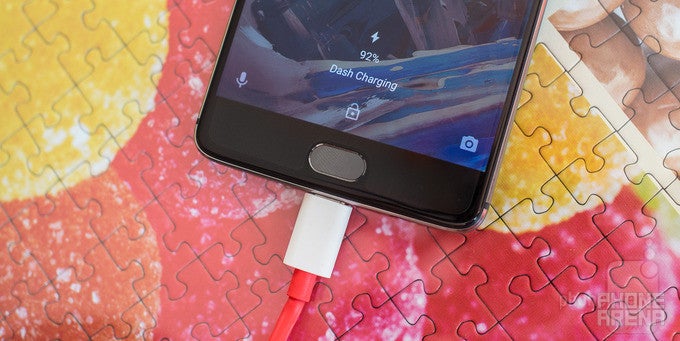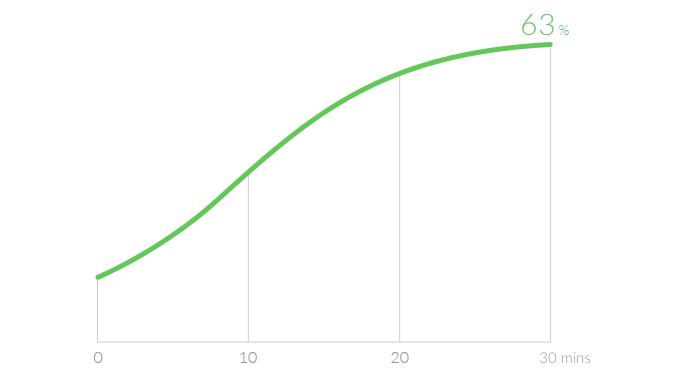How it works: Dash Charge fast charging on the OnePlus 3

Battery life is still considered one of the weaker spots of modern smartphones. As we shared in a recent battery life study of ours, the average smartphone does not last any longer between charges compared to counterparts from a couple of years ago, and there's no way we can call this progress. On a positive note, smartphones now charge much faster – about 65% faster on average – and that is greatly thanks to the implementation of fast-charging technologies. For instance, Qualcomm Quick Charge is supported on recent phones by Samsung, LG, and HTC, as well as on recent Moto models.
Now there's this new Dash Charge – a fast charging solution based on OPPO's VOOC – and it is available to owners of the OnePlus 3. Promising "a day's power in half an hour", the technology needs just 30 minutes to replenish two thirds of the smartphone's battery capacity, which is pretty remarkable. But what kind of sorcery is behind Dash Charge and is it any better than other fast-charging implementations? Allow us to shed some light on the matter.
What makes fast charging fast?

The 3000mAh lithium battery inside the OnePlus 3. Image via FoneArena
Of course, even though slower charging is safer, nobody likes to wait forever for their phone to charge. This is where fast charging comes into play. On a fundamental level, all fast charging technologies work the same way – by cramming as much power into the battery as it can safely handle. Lithium batteries can be fed more power when they're empty or below a certain charge threshold, and every fast charging methodology takes advantage of this property. Once this threshold is reached, the flow of power is reduced to a safe level. This explains why phones boasting fast charging in any form charge faster from zero up to a certain battery percentage, then slow down the process to prevent damage to the battery. The OnePlus 3, in particular, takes only 30 minutes to charge from empty to 63%, but then it needs another 44 minutes to reach full capacity.
How is Dash Charge special?
From a broader perspective, Dash Charge on the OnePlus 3 is not all that different. Just like other quick-charging solutions, it starts by delivering a massive amount of power to the battery, gradually reducing the rate of charge as the cell is filled up. Where it sets itself apart, however, is in the way power is being sent from the charger to the phone. Quick Charge – the aforementioned technology by Qualcomm, used in recent Samsung, LG, HTC and Moto phones – applies higher voltage to increase the flow of power. Dash Charge, on the other hand, uses greater current. Both solutions get the job done, but they come with a few notable strengths and weaknesses.

Dash Charge delivers lots of power at first and then gradually reduces the flow of charge
Qualcomm Quick Charge scores points for its greater compatibility. Connect any QC-compatible phone to any QC-compatible charger and boom: you have quick charging. The USB cable that you connect the two with does not matter much, as long as it has the appropriate connectors at its ends. Dash Charge, however, demands you to use both the charger and the cable provided with the OnePlus 3. This is done with safety in mind – an ordinary cable may not be able to handle all the power safely.
At first, this might not make any sense. Both Dash Charge and Quick Charge carry up to 15-20-ish watts of power, so why does the latter need a special cable? Well, it is because in an electric circuit, greater current requires thicker wires. Greater voltage – not as much. This is why Qualcomm Quick Charge will work with an ordinary USB cable, while Dash Charge requires the thicker cable bundled with the OnePlus 3. If an ordinary cable is used, the phone will recharge at a slower rate.

Dash Charge on OnePlus 3 requires the stock charger and cable
But why was Dash Charge designed like this despite this obvious inconvenience? Because this keeps the OnePlus 3 cooler while charging. Phones with Qualcomm Quick Charge support have a special circuit in them that reduces the high voltage coming out of the charger to something that the battery can handle. This generates heat inside the phone – heat that might slow down the phone's CPU and GPU and that could slow down the charging process. On top of that, exposing a battery to excess heat is a surefire way of reducing its lifespan. Dash Charge, on the other hand, has most of the voltage- and current-regulating circuitry built inside the charger, so there's very little inside the OnePlus 3 that can produce heat while charging. As a result, there's a lower chance of CPU and GPU throttling if you choose to play a game while your OnePlus 3 is charging. Also, the rate of charging is less likely to be affected.
So, is Dash Charge the better fast-charging technology?
Well, it all depends on how you look at it. Dash Charge has its inconveniences, but thanks to it, the OnePlus 3 charges remarkably fast. Right now, it is one of the fastest-charging smartphones we've ever put to the test, standing firmly in the #4 spot on the chart, above hundreds of other handsets. 15 minutes of charging take the OP3 from zero to 19%. In half an hour, it reaches 63%. After an hour of charging, its battery gauge is already pointing at 96%. Full capacity is reached in just 1 hour and 14 minutes. To put these figures into perspective, the OP3 charges faster than the Galaxy S7, the LG G5, the HTC 10, the iPhone 6s, or the Sony Xperia Z5, and all of these phones have batteries of similar or smaller capacity.
But as we already mentioned, Dash Charge has its caveats. It is important to know that the only way of charging the OnePlus 3 rapidly is by using an official Dash Charge wall/car charger and an official Dash Charge USB cable. The two cost $33 bundled, and the only place you can buy them is the OnePlus store. In comparison, there more than a dozen chargers compatible with Qualcomm Quick Charge, and most USB cables would get your phone refilled.
Where do you stand in this clash between charging speed and convenience? Let us know in the comments!

Follow us on Google News











Things that are NOT allowed:
To help keep our community safe and free from spam, we apply temporary limits to newly created accounts: